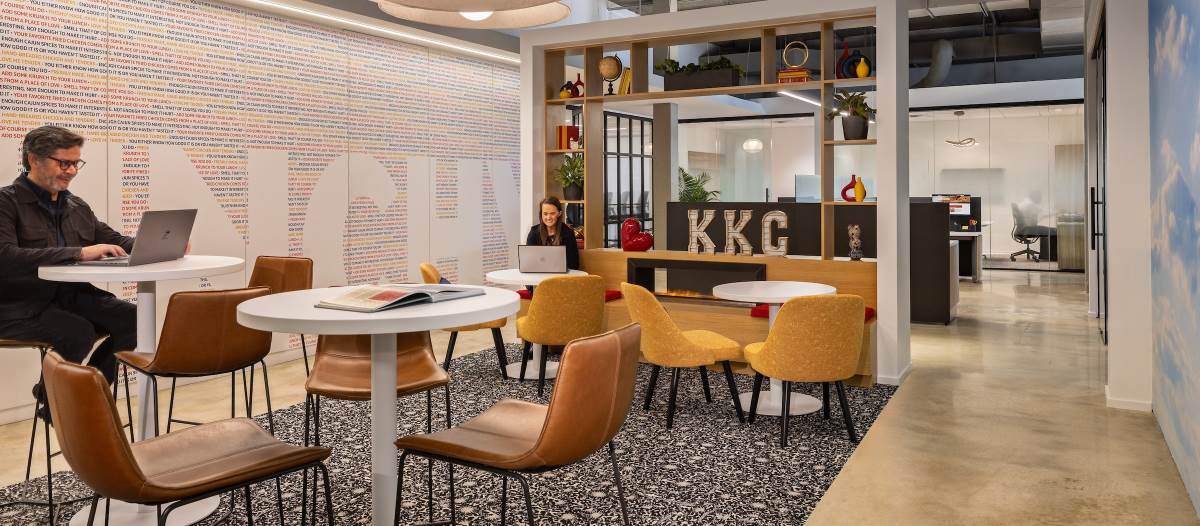Eyeing the Future
Design flexibility for cost-effective adaptability

Flexible design supports a facility’s present needs while keeping an eye toward the future. When a building is planned to be flexible, it can adapt to sudden or foreseen changes, allowing it to enjoy a longer lifespan than more stagnant architecture. Further, flexibly designed facilities can support more sustainable and cost-effective operation by providing built environments that can be reimagined through the years. This reduces the need for new construction since a building, or part of a building, can be modified easily to fit a new purpose.
Flexible design supports a facility’s present needs while keeping an eye toward the future. When a building is planned to be flexible, it can adapt to sudden or foreseen changes, allowing it to enjoy a longer lifespan than more stagnant architecture. Further, flexibly designed facilities can support more sustainable and cost-effective operation by providing built environments that can be reimagined through the years. This reduces the need for new construction since a building, or part of a building, can be modified easily to fit a new purpose.
Although flexible design can provide long-lasting solutions for most architectural projects, it provides several unique benefits to facilities with goals to provide changing services well into the future, such as health care and educational settings. As the past few years have shown, the ability for these buildings to quickly respond to shifts in occupant needs can have a substantial impact on long-term viability. Additionally, as advances in technology change what is possible within the built environment and how occupants work within a building, flexible design can support the integration of said advances without having to drastically redesign an entire wing, floor or building.
When planning for flexible design, it is important to realize those plans with architectural systems that are resilient. Doing so further minimizes operation and maintenance costs by supporting long-term use without the need for repair or replacement. Though difficult, this is possible — especially when facility managers look to specific elements that can support these goals, such as doors. Because doors repeat throughout a built environment and set a limit on what a room can accommodate, they can be integral to flexible design.
What is flexible design and how does it contribute to long-term viability
Flexible design is the ability for a project’s base build to be repurposed, within reason, to cater to changes in need, market and other accommodations to secure a longer lifespan for the built environment. This definition, while straightforward, leaves a lot open as to how FMs and building teams can achieve flexibility.
For example, in education, design flexibility can relate to the ability of a space to accommodate a variety of teaching and learning methods. This can include specifying oversized doors that, when opened, turn two adjacent spaces into a large one, facilitating multiple types of lesson plans, from group work to experiential learning and more.
However, for true flexibility it was also important that these door systems could also close to provide a quiet space for concentrated independent work, which would ensure multiple uses could occur in the space. The specified sliding doors were able to provide premium acoustic performance to reduce noises outside the classroom from interfering with activities within it.
Flexible design in the health care sector can mean creating rooms that can reasonably accommodate moveable equipment or planning the efficient use of space to optimize the number of rooms within a building’s exterior walls, thereby increasing both the number of patients and services a health care center can provide. FMs can also improve the useability of a space to support long-term occupant satisfaction and investment. This continues to be a crucial part of design and management as more medical centers consolidate different types of care within the same facility.
Importance of designing for flexibility: total cost of ownership
Flexible design also supports a more sustainable facility because fewer renovations can translate to fewer materials in landfills and a reduction of carbon emissions from new construction, not to mention the significant environmental benefits of reuse versus new construction. For FMs and building owners, flexible design can shrink the total cost of ownership by minimizing both planned renovation and day-to-day maintenance expenses.
For example, the University of Iowa Hospitals and Clinics’ (UIHC) Heart and Vascular Center at the John Pappajohn Pavilion in Iowa City, Iowa, USA, used sliding doors to more easily facilitate an on-stage/off-stage design. Known to improve wait times for patients and offer more opportunities for staff to collaborate, the on-stage/off-stage design allowed UIHC’s Heart and Vascular Center to work with medical staff to quickly adapt to changes in need — whether that would be managing unexpected patient surges or providing ample opportunities for staff to meet and coordinate care. This, in turn, can reduce the need to renovate as spaces may fit more than a facility’s current needs, supporting more efficient operations from both budget and ecological perspectives. On-stage/off-stage design also frequently minimizes the footprint of waiting areas and other spaces leading to an overall efficiency in a building’s floorplan.
Additionally, flexible openings, specifically wider doors, can more easily allow the movement of large equipment between spaces — all with a lowered risk of damaging walls and doorframes in the process. Further, when occupants do not have the need to alter a space as a short-term solution, there are fewer opportunities for those alterations to result in building or fire code inspections. As a result, FMs may see fewer repair requests and a smaller bottom line to their planned maintenance costs.
With a greater overall lifespan, flexibly designed buildings may also benefit from architectural systems that are resilient and can correct imperfections in construction — whether those imperfections are a consequence of human error or site settlement.
Reducing maintenance costs with resiliency
A longer lifespan can translate to a lower cost of ownership. However, long-term viability puts additional strain on architectural elements since they will be used more over the course of the building’s operation. As such, facility professionals may see an increase in repair costs if they choose products that are not robust enough to endure typical wear and tear.
Resiliency is an important adjacent concern when considering design flexibility. As one of the most frequently used parts of the built environment, doors should be durable to maintain a facility’s ability to operate. The essential nature of resilient door systems is particularly important for flexibly designed buildings as these assemblies are often integral to achieving flexibility.
For example, in an education space that has breakout rooms, it is as important for these door systems to support both collaborative and solo study. Without being able to do both, the functionality and flexibility of these types of spaces is compromised. This design was incorporated into a high school in a Seattle, Washington, USA, suburb. The breakout spaces could be used for student-teacher conferences or independent study because the doors used perimeter and drop-down seals to block a large amount of ambient noise. Their acoustic performance also helped them support group work that did not interrupt adjacent areas, so it was important that the seals remain functional even after years of use.
Seals are not the only components that need to be robust. Hardware, closers and framing are all essential to creating a more resilient opening. When commercial sliding door assemblies come with a top-hung roller system encased in a heavy-duty frame, it reduces the possibility of damage and need for routine cleaning. Further, soft closers, in combination with a heavy-duty perimeter frame, help protect the system and surrounding wall from impact. This can reduce the cost of maintenance over the course of a building’s lifespan, complementing the savings to cost of ownership when a facility is designed to be flexible.
Incorporating design flexibility in retrofits
While discussions around flexible design often fixate on new construction, this concept is equally applicable to renovations. The incorporation of commercial sliding door systems for retrofits can help facilitate more flexible openings to achieve interiors that readily adapt to seen and unforeseen changes in needs. Pacific Medical Centers’ (PacMed) renovation of the Gately-Ryan Building in Renton, Washington, USA, provides a poignant example in health care.
Because sliding doors eliminate swing arc trajectories, they can save up to 30 square feet per door — a benefit that accumulates throughout a floor. For the PacMed retrofit, this freed enough space to plan an extra exam room for every 11 originally inside the building. For day-to-day operation, this helped the Gately-Ryan Building streamline operation. As part of a flexibly designed retrofit, the additional rooms could also be used in the event of patient surges, a situation encountered across the globe in the earliest months of the COVID-19 pandemic.
This is just one example. Sliding doors used within renovated spaces can help create wider openings even when hallways would not allow larger swing arcs. Specifically for health care, when these doors are specified with perimeter and dropdown seals, they can provide premium acoustic performance and support the design of pressurized environments. Both capabilities allow rooms within medical centers to be code compliant and within facility design best-practice guidelines for a variety of uses.
In addition to a sliding door system’s ability to create flexible spaces for retrofits, select door assemblies come with back track systems that can account for and correct imperfections in real-world construction. This ensures buildings that have since shifted out of square can still maintain long-term functionality and flexibility.
Open the doors to design flexibility
The reasons to incorporate flexibility into a new or retrofit design are as myriad as the benefits this strategy provides its occupants, both now and in the future. This concept can help buildings remain adaptable to changes in technology and needs. It can also help facilities more readily unify different services under a single roof, a trend that is gaining steam in the health care system as more medical centers consolidate and diversify services.
For FM professionals, considering expenditures that promote flexibility can lead to reduced maintenance costs, as well as minimize budgets for future renovations to help keep pace with changing market needs. Both results can shrink the total cost of ownership over a building’s life cycle, allowing FMs to plan for upgrades and services that may have previously seemed cost prohibitive.
The use of commercial sliding doors can be a cost-effective way to facilitate design flexibility, as well as space efficiency and occupant comfort. Likewise, when these doors are manufactured with high-quality components, they can withstand the strain of longer lasting buildings. Both qualities make them extremely viable options for planning a facility that can accommodate present and future needs, both sudden and foreseen.

Tysen Gannon, LEED AP, AD Systems has more than 15 years of experience in the architectural products industry, including roles in sales, product management, research and marketing, with a focus on glass and glazing, fenestration and façade systems.
Read more on Occupancy & Human Factors , Real Estate and Workplace
Explore All FMJ Topics









